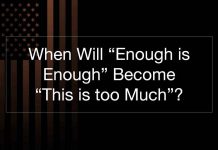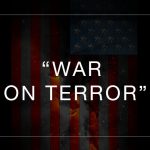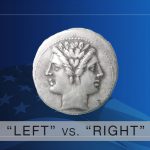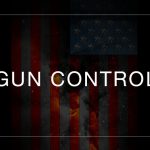Last Updated on October 2, 2021 by Constitutional Militia
Investment advisors often remind their clients that the Chinese character for “crisis” also means “opportunity”. Similarly, many people argue, expect, and even hope that a severe crisis in America’s monetary and banking systems will provide the necessary and sufficient opportunity for reform along free-market and constitutional lines.
According to this train of thought, the inevitable and unavoidable collapse of the Federal Reserve System is desirable:
- first, completely to discredit fiat currency and fractional-reserve central banking;
- second, to shock both people in general and politicians in particular into realizing that silver and gold must be reintroduced as media of exchange, central banking must be eliminated, and the incestuous economic and political coupling between the government and the banks must be permanently severed;
- third, to provide the groundswell of public outrage necessary to force Congress and the President to act; and especially
- fourth, to leave politicians with no alternative but to restructure the monetary and banking systems along free-market and constitutional lines.
Some exponents of this position go even further, contending that fundamental reform is actually impossible without such a collapse.
In fact, the exact opposite of this theory is far more likely to be correct:
A. Any regime of fiat currency and fractional-reserve central banking operates at base as a confidence game or Ponzi scheme. Therefore, its instability and the likelihood of its collapse depend, not only on hard and fast economic facts, but also on volatile public attitudes, emotions, and reactions; on the often inaccurate and even dishonest propaganda bankers and politicians put out; on sudden eruptions in foreign affairs; and on other usually unforeseen and often unforeseeable events and influences. For that reason, in such a regime the timing of any crisis is unpredictable. So planning for how to deal with a crisis becomes difficult, if not impossible. Thus, if a “crisis” truly merits that denotation, it will occur when this country is least prepared for it—economically, politically, and psychologically. An event with seriously destructive consequences which is unpredictable, and the victims of which are unprepared, is better characterized as a “disaster” than as an “opportunity”.
B. A monetary and banking crisis will create circumstances conducive less to calm and rational thinking, and to social solidarity in mutual adversity, than to hysteria, demagoguery, class warfare, and mass political manipulation.
For example, in a depressionary crisis (such as occurred in the 1930s), people will be desperate to find quick and easy escapes from floods of bankruptcies and foreclosures, from mass unemployment, and from curtailment of essential public services. But, at least for common Americans, no panaceas will be discoverable. Impotence in the face of impoverishment—coupled with ignorance of its cause and inability to implement a solution—will engender desperation.
The courts, inundated with litigation brought by creditors against debtors, will enter one all-inclusive judgment: “Pay up!” Being lap dogs of the Establishment, judges will employ all of their well-honed skills of kangaroo jurisprudence to function as merciless collection agents for the banks, mortgagors, credit-card companies, and other voracious bloodsuckers to whom so many Americans are indebted beyond any hope of repayment. Mammoth redistribution of wealth will occur by . (Perhaps this is the subtext of the contemporary push for “bankruptcy reform”.) But no one will be allowed to challenge the fundamental fraudulence of the system that encouraged and constructed such an unsustainable pyramid of debt in the first place.
To be sure, when Americans are told that “justice” and “the rule of law” require them to forfeit their accumulated savings and economic security to the very institutions and individuals who enticed them out on the financial limb that the Establishment then sawed off, justifiably violent animosities towards the powers that be will arise among some citizens. For most victimized Americans, though, politicians, bankers, high finance, big business, and the intelligentsiia will finger scapegoats on whom wrongly to pin the blame for the crisis and its aftermath. This will generate increased confusion, recriminations, conflicts, and social chaos; and further divide, disarm, and ultimately defeat the forces that, if united, might effectively oppose the Establishment.
In addition, rather than disseminating demands for sound money and honest banking in order to deal with the crisis, the controlled media will orchestrate calls for massive increases in the supply of fiat currency and credit, ostensibly in order to enable common people to pay their debts. Of course, this will necessitate the maintenance of fractional-reserve central banking to emit the new currency, as well as the creation of more, more, and even more debt to serve as “security” for these emissions—thereby perpetuating the cause of the crisis and ensuring that further crises will break out later on. In this way, credulous Americans will be duped into chaining themselves to new debts in order to pay off their old ones, rendering permanent their financial indentured servitude to the Establishment.
An event which triggers psycho-social destabilization and provides ammunition for the Establishment to wage psycho-political warfare is better characterized as a “source of social psychoses” than as an “opportunity”. Indeed, people suffering from politically induced derangement can hardly be expected to recognize an “opportunity” at all, let alone to take advantage of it.
C. These socially destructive psycho-political effects will be intense, because economically the next major monetary and banking crisis will be far worse than any America has ever experienced.
America’s most extensive monetary and banking crisis encompassed the stock-market crash of 1929, the banking collapse in 1931-1933, and the Great Depression that dragged on until this country’s entry into World War II. Although the fascist and socialist policies the Roosevelt Administration rammed through Congress during the 1930s severely retarded economic recovery, they did not render it next to impossible by destroying a rational structure of free-market prices. True, common Americans were not allowed to possess gold for use as currency, or to make contracts payable in gold, after 1933. But, internationally, the United States remained on a “gold standard” at a fixed valuation of 35 “dollars” per ounce (13.71 grains of gold per “dollar”). And, domestically, prices for goods and services were stated in “dollars” that were either actual silver coins of the constitutional standard (371.25 grains of silver per “dollar”) or fiduciary paper currencies (United States Silver Certificates, United States Notes, or Federal Reserve Notes) redeemable in such coins “dollar for dollar” as a matter of law. The fractional-reserve banks may have collapsed. And gold may have been removed from the monetary system domestically. But international and domestic prices based on a “gold standard” and a “silver standard”–and particularly the ability of the free market to maintain an economically rational structure of such prices—remained. For even during the worst excesses of the Roosevelt Administration, in the final analysis a “dollar” available to average Americans at home was a fixed amount of fine silver, and a “dollar” available to bankers overseas was a fixed amount of fine gold.
Today, such is no longer the case. All prices in America’s economy, both domestic and international, are stated, not in any commodity money, but in a purely political money: fiat Federal Reserve Notes, irredeemable in gold or silver as a matter of law. See Title 31, United States Code, Section 5118(b, c). No “gold standard” or “silver standard” exists on which the free market could fall back to set prices were Federal Reserve Notes (say) to self-destruct in hyperinflation, as did the German Mark in 1923. And no such standard could easily be created from scratch on the spur of the moment in the aftermath of a crash, even if the Establishment wanted to do so.
Thus, not only is the present Federal Reserve Ponzi pyramid far more bloated than the central bank’s currency and credit balloon of the 1920s, but also it stands on a far shakier foundation, because the “dollars” of the 1920s were “gold dollars” or “silver dollars”, whereas the “dollars” of the present era are political “dollars” with no legally fixed value in any commodity. This is far worse than Charles Ponzi’s original scheme. For Ponzi based his pyramid on his receipts of some actual “gold dollars”, “silver dollars”, or paper currencies redeemable therein. And it is worse than the Federal Reserve’s first pyramid that crashed in 1931-1933. For then the central bank had to maintain a 40% reserve of gold for its Federal Reserve Notes in circulation, which limited the possible Ponzification of the system (albeit still not enough to prevent collapse). Today, gold and silver play no controlling role whatsoever in the Federal Reserve System: Federal Reserve Notes are not redeemable in any amount of gold or silver, howsoever small. No amount of gold or silver is required as a reserve. No one pays gold or silver into, or withdraws them from, the banking system as ordinary currency. And the banks provide no special gold or silver accounts out of which payments for commercial transactions can be made in those metals pursuant to “gold-clause contracts” (although such contracts are lawful under Title 31, United States Code, Section 5118(d)(2)).
For these reasons—and because no one outside the banks supplies a parallel gold or silver currency that is as yet widely used—the free market does not state prices for goods and services generally in gold or silver, as well as in Federal Reserve Notes.
So, what would happen if the Federal Reserve System were to go belly-up tomorrow? If Federal Reserve Notes lose their “currency” (that is, become no longer capable of performing the functions of a medium of exchange), in what medium of exchange will prices of goods and services be stated? How long will it take for a new medium to be employed, and for most prices to be determined and expressed therein? And, in the interim, how extensive will be the economic losses such a monetary dislocation causes? One must conclude that, were the Federal Reserve System to fail catastrophically, the economic cost would be staggering.
On this reckoning, then, a collapse of the Federal Reserve System would constitute no “opportunity”, but rather a death sentence for the free-market’s price structure.
D. Perhaps most worrisome overall, though, is that, were the Federal Reserve to tumble down tomorrow, the political usurpation and tyranny that would likely arise from the rubble would dwarf in size, scope, and Stalinist savagery even the worst of Franklin Roosevelt’s grabs for unconstitutional power.
In the 1930s, Roosevelt’s response to the collapse of the Federal Reserve System was not (as it ought to have been) to prosecute the bankers and reform the monetary and banking systems along free-market and constitutional lines. Instead, he assumed “emergency” powers of a decidedly dictatorial cast, and with these powers actually tightened the stranglehold of the Treasury and the banks on America’s economy.
The legacy of Roosevelt’s usurpation and tyranny remains on the books in a statute which no one concerned about this country’s future can read and ponder often enough:
In order to provide for the safer and more effective operation of the national Banking System and the Federal Reserve System, to preserve for the people the full benefits of the currency provided for by the Congress through the national banking system and the Federal reserve system, and to relieve interstate commerce of the burdens and obstruction resulting from the receipt on an unsound or unsafe basis of deposits subject to withdrawal by check, during such [financial] emergency period as the President * * * by proclamation may prescribe, no member bank of the Federal reserve system shall transact any banking business except to such extent and subject to such regulations, limitations and restrictions as may be prescribed by the Secretary of the Treasury, with the approval of the President. Any individual, partnership, corporation, or association, or any director, officer or employee thereof, violating any of the provisions of this section * * * shall be fined not more than $10,000 or * * * be imprisoned for a term not exceeding ten years. Each day that any such violation continues shall be deemed a separate offense.
Title 12, United States Code, Section 95(a).
Self-evidently, this is a formula for a national financial dictatorship, enforced with penalties the ferocity of which might give even Nicolai Yezhov pause. (Apparently, though, no one in Washington, D.C., has noticed the incongruity of declaring that “the safe[ ] and * * * effective operation” of the banks and “the full benefits of the currency” can supposedly be secured in the event of a crisis only by imposing a dictatorship and impoverishing and imprisoning those who violate the dictator’s “regulations, limitations and restrictions”. Why cannot the same brilliant and benevolent politicians who claim the ability to devise appropriate “regulations, limitations and restrictions” after a crisis breaks out not write laws before it occurs that will prevent it altogether?)
Even the most abusive precedents established under Roosevelt, however, will not define the outermost reaches of the “emergency” powers contemporary public officeholders will seize in the event of a new monetary and banking crisis. Rather, they will employ whatever police-state tactics they deem necessary to deter and punish violations of their “regulations, limitations and restrictions”—from fines and forfeitures of property to incarceration in prison cells, internment in prison camps, and interment in graves.
This is so obvious that it even leaps off the pages of the otherwise censored mass media. For example, just before the presidential election of 2004, I chanced upon three articles in a New Hampshire newspaper. One recited warnings from various economists, Treasury officials, and financial experts that the indebtedness of the United States had already reached some astronomical, hopelessly unpayable figure (in the many tens of trillions of “dollars”). The second story reported that both President Bush and Senator Kerry were promising the electorate that they would increase the General Government’s expenditures on medical care for the elderly, Bush by a very large amount, Kerry by much more. The third article described a special unit in the police force of a New Hampshire city, with a photograph that depicted men wearing military-style helmets and battle dress and brandishing automatic weapons, along with an armored vehicle. Pointing out these stories to a New Hampshire State Legislator, I explained the logical connection among them: first, that this country is on the verge of an inevitable financial melt-down; second, that politicians are intent on making things even worse; and third, that when the Ponzi pyramid collapses, the same politicians whose irresponsibility caused the situation will impose draconian restrictions on common Americans by means of police forces amply provided with weapons and heavy equipment suitable for house-to-house fighting in Stalingrad. (The juxtaposition of these stories in the same paper on the same day may have been purely coincidental. It may also be that the editors unconsciously recognized the interrelationship. Or perhaps they intentionally sent their readers a subliminal message.)
Moreover, that New Hampshire city is no isolated example of the phenomenon of hyper-militarization of local police in response to politicians’ fears of coming mass disorders. Assorted SWAT teams, anti-“terrorist” squads, and other para-military units—with weapons and equipment more fearsome and effective than were deployed by a typical infantry company of the Waffen SS; and all of them interlocked with various “homeland security” agencies of the General Government—are spreading, like some Heinrich Himmlerite melanoma, across the country.
One may justifiably ask why any city in New Hampshire (or anywhere else in a free America, for that matter) legitimately needs detachments of what amount to panzer grenadiers that are not parts of the constitutional Militia. But one should entertain no doubt that, anywhere in the United States during a financial collapse, if they command “the boots on the ground” public officials will have no compunctions against using these myrmidons to compel common Americans to toe the party line. (The present-day “boots” terminology is rather ominous: As O’Brien told Winston Smith in Orwell’s 1984, if one wants a picture of the future, imagine a boot stomping on a human face—forever.)
Even more than Franklin Roosevelt, contemporary public officials consider themselves above the Constitution—which, being what they call a “living” document, means whatever those in power find convenient. Worse yet, they consider themselves free of the strictures of traditional morality—which apparently died along with God, when the Establishment imposed “separation of church and state” as America’s secular religion. Indeed, the Supreme Court has informed all Americans that the Justices can now interpret the Constitution according to “authorities” they themselves select that “point[ ] in an opposite direction” from “the history of Western civilization and * * * Judeo-Christian moral and ethical standards”. Lawrence v. Texas, 539 U.S. 558, 572-73 (2003) (Anthony Kennedy, J., for the Court). And if the Supreme Court can do this for itself, surely it can authorize Congress and the President, or the Department of Homeland Security, or some trigger-happy local SWAT-team commander to do so, too.
What manner of “authorities” “point[ ] in an opposite direction” from “the history of Western civilization and * * * Judeo-Christian moral and ethical standards”? And in what sort of a country will Americans find themselves when their laws are written and construed according to such “authorities”, and then executed by para-military thugs, obeying orders that “point[ ] in [that] opposite direction”? Why, an uncivilized and immoral country, the perfect country in which to put down by bludgeons and bullets mass civil disobedience arising out of a monetary and banking crisis.
So, the main “opportunity” such a crisis will offer will be for the Establishment to set aside what little remains of the Constitution that limits public officials’ powers—which means the end of America. Why Americans should welcome the “opportunity” to end America is difficult to understand.
But if Americans should not wait—and certainly should not hope—for a crisis to jump-start reformation of the monetary and banking systems, what should they do? Stay in touch with this web site for some suggestions.
©2005 Edwin Vieira, Jr. – All Rights Reserved.




































